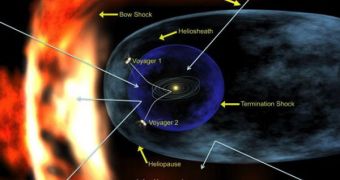According to experts at the American space agency, the concentration of cosmic-ray radiation around us has increased considerably this year, reaching its highest level in more than 50 years of observations. The level of cosmic rays has been under constant surveillance since the advent of the space age, and such a sharp increase has never before been observed, scientists from the California Institute of Technology (Caltech) report. NASA's ACE (Advanced Composition Explorer) spacecraft sent back the new results, LiveScience reports.
“In 2009, cosmic ray intensities have increased 19 percent beyond anything we've seen in the past 50 years. The increase is significant, and it could mean we need to re-think how much radiation shielding astronauts take with them on deep-space missions,” Caltech expert Richard Mewaldt explains, adding that the boost in cosmic-ray concentrations has no adverse effect on the Earth and the life forms it supports. He also reveals that the most likely reason for this is the current solar minimum, a period of very low activity from the Sun that began in 2007.
Astronomers know that, when less solar activity is recorded, cosmic-ray readings go up. This happens because sunspots, solar flares and sun storms have the ability to generate a cosmic bubble of sorts around our solar system, in effect fighting off the invading radiation. Since no such occurrences take place in the star, more and more cosmic rays can penetrate the solar system, and reach even its innermost planets. “We're experiencing the deepest solar minimum in nearly a century, so it is no surprise that cosmic rays are at record levels for the Space Age,” Goddard Space Flight Center expert Dean Pesnell says.
“Measurements by the Ulysses spacecraft show that solar wind pressure is at a 50-year low, so the magnetic bubble that protects the solar system is not being inflated as much as usual,” the Caltech scientist adds. Because the Sun's magnetic field is weak, cosmic rays no longer have to put up a huge effort in “swimming upstream” against the solar wind. “If the flattening continues as it has in previous solar minimum, we could see cosmic ray fluxes jump all the way to 30 percent above previous Space Age highs,” the expert believes.
But this type of occurrences is not a new one. Centuries ago, cosmic-ray concentrations grew to be as much as 200 percent more intense than they are now, yet humankind survived. In addition to being protected by the Sun, we are also safeguarded by our planet's own magnetic field, which is strong enough to deflect the vast majority of incoming space radiation, or convert it into harmless, elementary particles.

 14 DAY TRIAL //
14 DAY TRIAL //